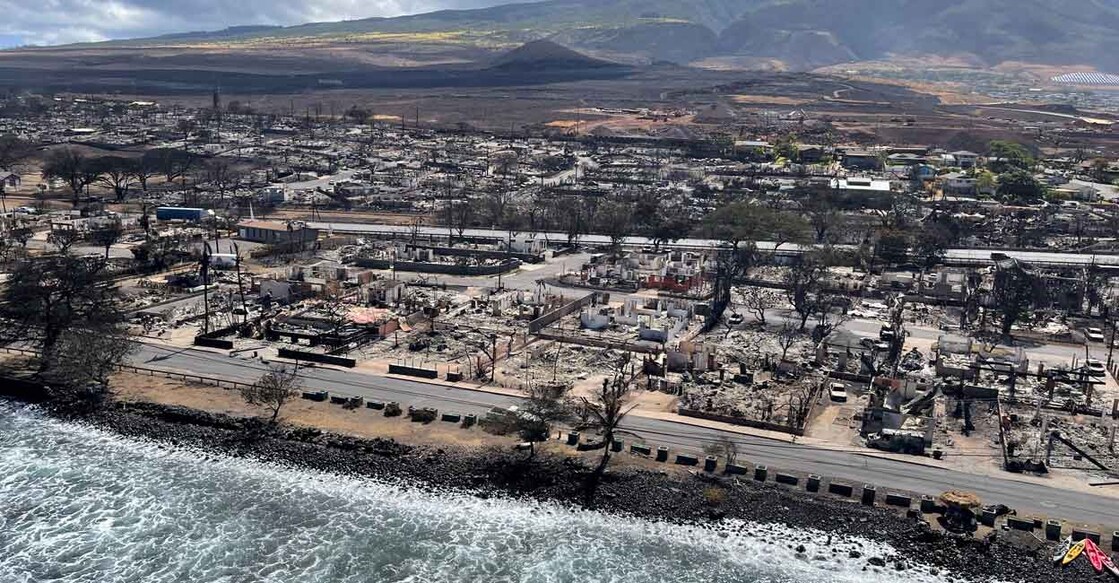Maui inferno: Explaining the deadliest wildfires in US history

Mail This Article
The Maui wildfires in Hawaii have killed at least 93, making it the deadliest U.S. wildfire in more than a century, with the total likely to rise as cadaver dogs sift through the ruins of the historic resort city of Lahaina.
The causes of the Hawaii wildfires, which started on Tuesday night, have not yet been determined. Hawaii Governor Josh Green on Sunday called a part of the island of Maui that was devastated by wildfires a "war zone".
The deadliest wildfire in US history
The Peshtigo fire in Wisconsin started Oct. 8, 1871 and killed 1,152, according to the National Fire Protection Association (NFPA).
At the time, Peshtigo was permanent home to about 2,000 people, although its population swelled with immigrants looking for work in the lumbering, manufacturing and railroad industries.
The town was surrounded by pine forest, all of its structures were made of wood, including its sidewalks. Sawdust from the town's woodworking factory - the largest in the world - covered everything.
On Oct. 8, 1871, following a dry winter, spring and summer, the town was a particularly vulnerable when a low-pressure system kicked up a strong wind and transformed a nearby brushfire into a conflagration, which survivors described as a wall of fire that consumed the settlement within minutes, according to the Peshtigo Historical Society.
Cloquet and Great Hinckley fires
The Maui wildfire is the deadliest since the Cloquet Fire in October 1918, when railroad sparks ignited a wildfire that raged for more than four days, decimating northern Minnesota, according to the Library of Congress.
The NFPA set a death toll of 453 as a result of what is known today as the Cloquet/Moose Lake Fires.
In 1894, amid conditions strikingly similar to the Peshtigo fire 23 years earlier, a breeze kicked up and transformed several small, scattered fires near a cluster of logging communities into a wall of flame that destroyed Hinckley, Mission Creek, Sandstone, Miller, Partridge and Pokegama, according to the Hinckley government website.
The fire consumed 400 square miles and killed 418 people.
How vulnerable are US homes to wildfires
The Federal Emergency Management Association (FEMA) defines wildfires as "an unplanned, unwanted fire burning in a natural area, such as a forest, grassland, or prairie."
Nearly half the land area in the United States is composed of forest, shrubland, and grassland, according to the Environmental Protection Agency (EPA).
There are currently almost 45 million U.S. homes located near or adjacent to such areas.
The National Interagency Fire Center estimates there are 71.8 million properties in the United States that are "at some level of risk from wildfire."
Since 2018, wildfires in the United States have destroyed nearly 63,000 structures, the majority of which were homes.
What caused these fires to be deadly
The causes of some fires, including the most recent in Hawaii, are not known. However, dry and windy conditions were present for both the Maui fire this year and the California Camp Fire in 2018, as well as the Peshtigo fire in Wisconsin and the Hinckley fires in Minnesota.
Climate change and wildfires
Climate change increases hot and dry conditions that help fires spread faster, burn longer and rage more intensely. Hotter weather also saps moisture from vegetation, turning it into dry fuel that helps fires to spread.
Climate change is not the only factor in wildfires. Forest management and ignition sources also play important roles. Some actions can help to limit severe blazes, such as setting controlled fires that mimic the low-intensity fires in natural ecosystem cycles, or introducing gaps within forests to stop blazes rapidly spreading over large areas.
According to the EPA, since the 1980s, of the 10 years with the largest acreage lost to wildfires, all have occurred since 2004 and coincide with the warmest years on record nationwide.
Peak wildfire season is starting earlier in the year.
In 2022, there were 66,255 wildfires in the United States, compared with 18,229 in 1983, when record keeping began, per the National Oceanic and Atmospheric Administration (NOAA).
"Climate change, including increased heat, extended drought, and a thirsty atmosphere, has been a key driver in increasing the risk and extent of wildfires in the western United States during the last two decades," according to the NOAA.

